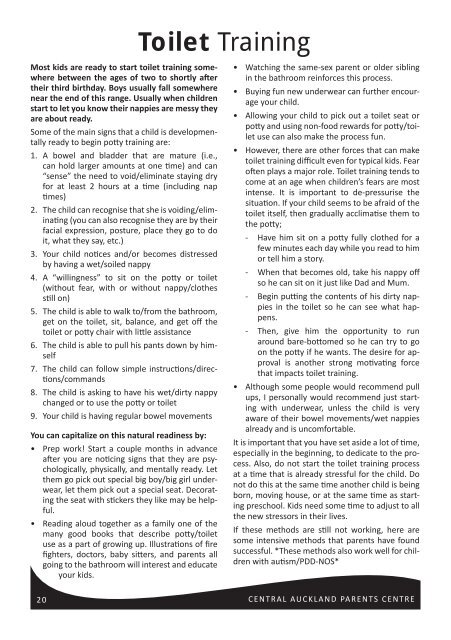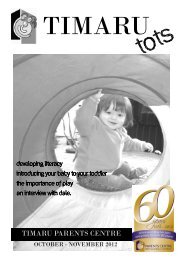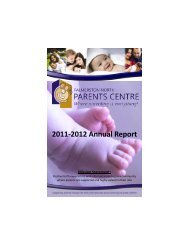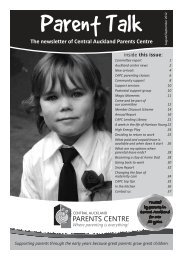News Letter Oct-Nov 2012 - Parents Centres New Zealand Inc
News Letter Oct-Nov 2012 - Parents Centres New Zealand Inc
News Letter Oct-Nov 2012 - Parents Centres New Zealand Inc
You also want an ePaper? Increase the reach of your titles
YUMPU automatically turns print PDFs into web optimized ePapers that Google loves.
Toilet Training<br />
Most kids are ready to start toilet training somewhere<br />
between the ages of two to shortly after<br />
their third birthday. Boys usually fall somewhere<br />
near the end of this range. Usually when children<br />
start to let you know their nappies are messy they<br />
are about ready.<br />
Some of the main signs that a child is developmentally<br />
ready to begin potty training are:<br />
1. A bowel and bladder that are mature (i.e.,<br />
can hold larger amounts at one time) and can<br />
“sense” the need to void/eliminate staying dry<br />
for at least 2 hours at a time (including nap<br />
times)<br />
2. The child can recognise that she is voiding/eliminating<br />
(you can also recognise they are by their<br />
facial expression, posture, place they go to do<br />
it, what they say, etc.)<br />
3. Your child notices and/or becomes distressed<br />
by having a wet/soiled nappy<br />
4. A “willingness” to sit on the potty or toilet<br />
(without fear, with or without nappy/clothes<br />
still on)<br />
5. The child is able to walk to/from the bathroom,<br />
get on the toilet, sit, balance, and get off the<br />
toilet or potty chair with little assistance<br />
6. The child is able to pull his pants down by himself<br />
7. The child can follow simple instructions/directions/commands<br />
8. The child is asking to have his wet/dirty nappy<br />
changed or to use the potty or toilet<br />
9. Your child is having regular bowel movements<br />
You can capitalize on this natural readiness by:<br />
• Prep work! Start a couple months in advance<br />
after you are noticing signs that they are psychologically,<br />
physically, and mentally ready. Let<br />
them go pick out special big boy/big girl underwear,<br />
let them pick out a special seat. Decorating<br />
the seat with stickers they like may be helpful.<br />
• Reading aloud together as a family one of the<br />
many good books that describe potty/toilet<br />
use as a part of growing up. Illustrations of fire<br />
fighters, doctors, baby sitters, and parents all<br />
going to the bathroom will interest and educate<br />
your kids.<br />
20<br />
• Watching the same-sex parent or older sibling<br />
in the bathroom reinforces this process.<br />
• Buying fun new underwear can further encourage<br />
your child.<br />
• Allowing your child to pick out a toilet seat or<br />
potty and using non-food rewards for potty/toilet<br />
use can also make the process fun.<br />
• However, there are other forces that can make<br />
toilet training difficult even for typical kids. Fear<br />
often plays a major role. Toilet training tends to<br />
come at an age when children’s fears are most<br />
intense. It is important to de-pressurise the<br />
situation. If your child seems to be afraid of the<br />
toilet itself, then gradually acclimatise them to<br />
the potty;<br />
- Have him sit on a potty fully clothed for a<br />
few minutes each day while you read to him<br />
or tell him a story.<br />
- When that becomes old, take his nappy off<br />
so he can sit on it just like Dad and Mum.<br />
- Begin putting the contents of his dirty nappies<br />
in the toilet so he can see what happens.<br />
- Then, give him the opportunity to run<br />
around bare-bottomed so he can try to go<br />
on the potty if he wants. The desire for approval<br />
is another strong motivating force<br />
that impacts toilet training.<br />
• Although some people would recommend pull<br />
ups, I personally would recommend just starting<br />
with underwear, unless the child is very<br />
aware of their bowel movements/wet nappies<br />
already and is uncomfortable.<br />
It is important that you have set aside a lot of time,<br />
especially in the beginning, to dedicate to the process.<br />
Also, do not start the toilet training process<br />
at a time that is already stressful for the child. Do<br />
not do this at the same time another child is being<br />
born, moving house, or at the same time as starting<br />
preschool. Kids need some time to adjust to all<br />
the new stressors in their lives.<br />
If these methods are still not working, here are<br />
some intensive methods that parents have found<br />
successful. *These methods also work well for children<br />
with autism/PDD-NOS*<br />
CENTRAL AUCKLAND PARENTS CENTRE
















